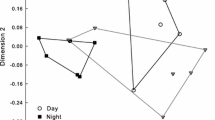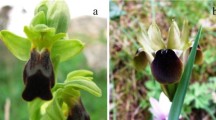Abstract
Orchids of the genus Ophrys are pollinated by males of solitary bees and wasps through sexual deception. Flowers mimic the odor of a receptive female and thus attract males that seek to copulate. Visual stimuli have been assumed so far to play only a minor role in male attraction. We investigated the role of the perigon as a potential visual signal in attracting pollinators in the orchid Ophrys heldreichii and its pollinator, the males of the long-horned bee Tetralonia berlandi (Apidae). In contrast to many other Ophrys species, O. heldreichii exhibits a large and bright pinkish perigon that appears visually conspicuous to a human observer. In a dual choice test we presented two flowers from a single plant and counted visitation rates. We then removed the perigon of one flower and retested the relative attractiveness of both flowers. For 292 male visits in ten trials we found a significant decrease of visitation rate for flowers with the perigon removed. In a second experiment we repeated the dual choice test using photos of the flowers. Males also significantly chose the picture of an intact flower over the picture of a modified flower where the perigon was digitally removed. From our data, we conclude that T. berlandi males respond to and are attracted by the bright pink perigon of the orchid in addition to other stimuli. A bright colorful perigon occurs almost only in the Ophrys holoserica-oestrifera group, a large sub-group of the genus. We hypothesize that this kind of visual signal is adaptive particularly in those Ophrys species where the targeted males patrol resourced-based encounter sites and strongly rely on their visual system while searching for their females.
Similar content being viewed by others
References
J. Alcock E. M. Barrows G. Gordh L. J. Hubbard L. Kirkendall D. Pyle T. L. Ponder F. G. Zalom (1978) ArticleTitleThe ecology and evolution of male reproductive behaviour in the bees and wasps J. Linn. Soc. London Zool. 64 293–326 Occurrence Handle10.1111/j.1096-3642.1978.tb01075.x
M. Ayasse F. Schiestl H. F. Paulus F. Ibarra W. Francke (2003) ArticleTitlePollinator attraction in a sexually deceptive orchid by means of unconventional chemicals Proc. Roy. Soc. London B 270 517–522 Occurrence Handle10.1098/rspb.2002.2271 Occurrence Handle1:CAS:528:DC%2BD3sXktVWhs7k%3D
M. Ayasse F. P. Schiestl H. F. Paulus C. Löfstedt B. Hansson F. Ibarra W. Francke (2000) ArticleTitleEvolution of reproductive strategies in the sexually deceptive orchid Ophrys sphegodes: How does flower-specific variation of odor signals influence reproductive success? Evolution 54 1995–2006 Occurrence Handle11209776 Occurrence Handle10.1554/0014-3820(2000)054[1995:EORSIT]2.0.CO;2 Occurrence Handle1:STN:280:DC%2BD3M3jt1KisQ%3D%3D
F. G. Barth (1991) Insects and flowers: The biology of a partnership Princeton University Press Princeton 424
R. M. Bateman P. M. Hollingsworth J. Preston Y.-B. Luo A. M. Pridgeon M. W. Chase (2003) ArticleTitleMolecular phylogenetics and evolution of Orchidinae and selected Habenariinae (Orchidaceae) Bot. J. Linn. Soc. 142 1–40 Occurrence Handle10.1046/j.1095-8339.2003.00157.x
L. Chittka P. G. Kevan (2005) Flower colour as advertisement A. Dafni P. G. Kevan B. C. Husband (Eds) Practical pollination biology Enviroquest Ltd. Cambridge, ON, Canada 157–196
L. Chittka A. Shmida N. Troje R. Menzel (1994) ArticleTitleUltraviolet as a component of flower reflection, and the colour perception of hymenoptera Vision Res. 34 1489–1508 Occurrence Handle8023461 Occurrence Handle10.1016/0042-6989(94)90151-1 Occurrence Handle1:STN:280:ByuB1MrhsFU%3D
L. Chittka J. Spaethe A. Schmidt A. Hickelsberger (2001) Adaptation, constraint, and chance in the evolution of flower color and pollination color system L. Chittka J. D. Thomson (Eds) Cognitive ecology of pollination Cambridge University Press Cambridge 106–126
L. Chittka H. Wells (2004) Color vision in bees: mechanisms, ecology and evolution F. Prete (Eds) Complex worlds from simpler nervous systems MIT Press Boston 165–191
P. Delforge (2005) Guide des Orchidées d'Europe, d'Afrique du Nord et du Proche-Orient EditionNumber3 Delachaux et Niestlé Lausanne, Paris 640
C. Detto (1905) ArticleTitleBlütenbiologische Untersuchungen. I. Über die Bedeutung der Insektenähnlichkeit der Ophrysblüte Flora (Allg. Bot. Zeitung, Marburg) 94 287–329
G. C. Eickwort H. S. Ginsberg (1980) ArticleTitleForaging and mating behavior in Apoidea Ann. Rev. Entomol. 25 421–446 Occurrence Handle10.1146/annurev.en.25.010180.002225
A. Gumbert J. Kunze (2001) ArticleTitleColour similarity to rewarding model plants affects pollination in a food deceptive orchid, Orchis boryi Biol. J. Linn. Soc. 72 419–433 Occurrence Handle10.1006/bijl.2000.0510
S. D. Johnson C. I. Peter A. Nilsson J. A. Gren (2003) ArticleTitlePollination success in a deceptive orchid is enhanced by co-occurring rewarding magnet plants Ecology 84 2919–2927
Kretzschmar H., Kretzschmar G., Eccarius W. (2002) Orchideen auf Kreta, Kasos, Karpathos. Selbstverlag, Bad Hersfeld.
B. Kullenberg (1961) Studies in Ophrys pollination Almquist & Wiksells Boktrykeri AB Uppsala 340
S. Künkele H. Baumann (1998) Orchidaceae, Orchideen O. Sebald S. Seybold G. Philippi A. Wörz (Eds) Die Farn- und Blütenpflanzen Baden-Württembergs, Bd. 8, Spezieller Teil Verlag Eugen Ulmer Stuttgart 286–462
J. Mant C. Brändli N. J. Vereecken C. M. Schulz W. Francke F. P. Schiestl (2005) ArticleTitleCuticular hydrocarbons as sex pheromone of the bee Colletes cunicularis and the key to its mimicry by the sexually deceptive orchid, Ophrys exaltata J. Chem. Ecol. 31 1765–1787 Occurrence Handle16222807 Occurrence Handle10.1007/s10886-005-5926-5 Occurrence Handle1:CAS:528:DC%2BD2MXmt1enurk%3D
H. F. Paulus (1988) ArticleTitleCo-Evolution und einseitige Anpassungen in Blüten-Bestäuber-Systemen: Bestäuber als Schrittmacher in der Blütenevolution Verh. Dtsch. Zool. Ges. 81 25–46
H. F. Paulus (1997) ArticleTitleSignale in der Bestäuberanlockung: Weibchenimitation als Bestäubungsprinzip bei der mediterranen Orchideengattung Ophrys Verh. Zool.-Bot. Ges. Österreich 134 133–176
H. F. Paulus C. Gack (1980) ArticleTitleBeobachtungen und Untersuchungen zur Bestäubungsbiologie spanischer Ophrys-Arten Die Orchidee, Sonderheft 1980 55–68
H. F. Paulus C. Gack (1983) Signal imitation as pollination strategy in the genus Ophrys (Orchidaceae) – Observations in the Mediterranean Verh. SIEEC X. Budapest 18–21
Paulus H. F., Gack C. (1984) Evolutionary significance of variability in Ophrys - learning experiments with pseudocopulating bee males - Proc. XVII. Int. Congr. Entomol. Hamburg: 440.
Paulus H. F., Gack C. (1986) Neue Befunde zur Pseudokopulation und Bestäuberspezifität in der Orchideengattung Ophrys - Untersuchungen in Kreta, Süditalien und Israel. In: Senghas K., Sundermann H. (eds.) Probleme der Taxonomie, Verbreitung und Vermehrung europäischer und mediterraner Orchideen II. Die Orchidee (Hildesheim), Sonderheft 1986: 48–86.
H. F. Paulus C. Gack (1990a) ArticleTitlePollinators as prepollinating isolation factors: Evolution and speciation in Ophrys (Orchidaceae) Israel J. Bot. 39 43–79
Paulus H. F., Gack C. (1990b) Zur Pseudokopulation und Bestäuberspezifität der Gattung Ophrys in Sizilien und Süditalien (Orchidaceae und Insecta, Apoidea). In: Senghas K., Sundermann H., Kolbe W. (eds.) Probleme bei europäischen und mediterranen Orchideen. Jahresber. Naturwiss.Ver.Wuppertal 43: 119–141.
H. F. Paulus C. Gack (1999) ArticleTitleBestäubungsbiologische Untersuchungen an der Gattung Ophrys in der Provence (SO-Frankreich), Ligurien und Toscana (NW.Italien) (Orchidaceae und Insecta, Apoidea) J. Eur. Orch. 31 347–422
R. J. Paxton J. Tengö (2001) ArticleTitleDoubly duped males: the sweet and sour of the orchid's bouquet Trends Ecol. Evol. 16 167–169 Occurrence Handle11245933 Occurrence Handle10.1016/S0169-5347(01)02121-8
A. Pouyanne (1917) ArticleTitleLa fécondation des Ophrys par les insectes Bull. Soc. Hist. Nat. Afr. Noire 8 6–7
D. Peitsch A. Fietz H. Hertel J. Souza Particlede D. F. Ventura R. Menzel (1992) ArticleTitleThe spectral input systems of hymenopteran insects and their receptor-based colour vision J. Comp. Physiol. A 170 23–40 Occurrence Handle1573568 Occurrence Handle10.1007/BF00190398 Occurrence Handle1:STN:280:By2B2czjs1c%3D
F. P. Schiestl M. Ayasse H. F. Paulus D. Erdmann W. Francke (1997) ArticleTitleVariation of the pollinator-attracting odor signals and reproductive success in Ophrys sphegodes subsp. sphegodes Miller (Orchidaceae) Mitt. Dtsch. Ges. Allg. Angew. Ent. 11 477–480
F. P. Schiestl M. Ayasse H. F. Paulus C. Löfstedt B. S. Hansson F. Ibarra W. Francke (1999) ArticleTitleOrchid pollination by sexual swindle Nature 399 421–422 Occurrence Handle10.1038/20829 Occurrence Handle1:CAS:528:DyaK1MXjvVyqsr4%3D
F. P. Schiestl M. Ayasse (2002) ArticleTitleDo changes in floral odor cause sympatric speciation in sexually deceptive orchids? Pl. Syst. Evol. 234 111–119 Occurrence Handle10.1007/s00606-002-0187-z Occurrence Handle1:CAS:528:DC%2BD38XovVWgtrc%3D
M. Soliva A. Kocyan A. Widmer (2001) ArticleTitleMolecular phylogenetics of the sexually deceptive orchid genus Ophrys (Orchidaceae) based on nuclear and chloroplast DNA sequences Molec. Phylogenet. Evol. 20 78–88 Occurrence Handle11421649 Occurrence Handle10.1006/mpev.2001.0953 Occurrence Handle1:CAS:528:DC%2BD3MXksF2mu70%3D
C. K. Sprengel (1793) Das entdeckte Geheimnis der Natur im Bau und in der Befruchtung der Blumen Friedrich Vieweg Berlin
K. E. Steiner V. B. Whitehead S. D. Johnson (1994) ArticleTitleFloral and pollinator divergence in two sexually deceptive South African orchids Amer. J. Bot. 81 185–194 Occurrence Handle10.2307/2445632
R. L. Tremblay J. D. Ackerman J. K. Zimmerman R. N. Calvo (2005) ArticleTitleVariation in sexual reproduction in orchids and its evolutionary consequences: a spasmodic journey to diversification Biol. J. Linn. Soc. 84 1–54 Occurrence Handle10.1111/j.1095-8312.2004.00400.x
W. Vöth (1999) ArticleTitleLebensgeschichte und Bestäuber der Orchideen am Beispiel von Niederösterreich Stapfia (Linz) 65 1–257
Author information
Authors and Affiliations
Corresponding author
Rights and permissions
About this article
Cite this article
Spaethe, J., Moser, W.H. & Paulus, H.F. Increase of pollinator attraction by means of a visual signal in the sexually deceptive orchid, Ophrys heldreichii (Orchidaceae). Plant Syst. Evol. 264, 31–40 (2007). https://doi.org/10.1007/s00606-006-0503-0
Received:
Accepted:
Published:
Issue Date:
DOI: https://doi.org/10.1007/s00606-006-0503-0




